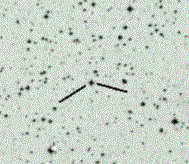Xcov 17 Scientific Justification


For the last 40 years we have assumed that the crystallization process takes place in the core of the cool white dwarfs (WDs). With the discovery of a massive pulsating WD, BPM37093, we now have the opportunity to detect observational evidence of crystallization for the first time. Recent theoretical calculations show we can use the period spacing between successive radial overtone modes to measure the crystallized mass fraction in the core. We are proposing to observe BPM37093 with the Whole Earth Telescope (WET), including CTIO, to search for more pulsation modes, fully resolve them, and most importantly, simultaneously overlap with granted time on the Hubble Space Telescope to independently determine the spherical spherical harmonics index, $\ell$, for each pulsation mode. Measuring the crystallization inside BPM37093 will provide constraints and calibration on the theory of crystallization. This has a profound impact on WD cosmochronology since the largest uncertainty associated with the age estimate of the oldest WDs has been the effect of crystallization.
We have begun an extensive observing campaign of the massive ($\approx 1.1M_{\odot}$) pulsating hydrogen atmosphere WD, BPM~37093, including a WET$^9$ campaign in April, 1998. BPM~37093 is an extremely important star as its high mass suggests its interior should be between 50 and 90\% crystallized$^{14}$. Although nearly four decades have passed since the prediction that the cores of cool WDs should crystallize$^{6,1,12}$, we still have no direct empirical tests of this theory.
Models show a crystallized core would have a strong effect on the observable pulsation modes of this star$^{14}$. The main effect we have identified is on the average spacing between modes of successive overtone number. We have used this spacing in the past to determine WD masses, and deviations from uniform spacing to determine the mass of surface layers of WDs. There is good agreement between spectroscopic and seismologic total masses, while surface layer masses can only be determined by seismology$^4$. If we assume BPM~37093's spectroscopically determined mass is correct, we can use the average period spacing to measure the fraction of the core which is crystallized and the deviations from the average to determine the surface H-layer mass.
Understanding crystallization is very important for studies of WD cooling. Winget et al.$^{13}$ have shown how we can use WDs as chronometers to measure the age of our Galaxy, which in turn serves as a lower limit to the age of the Universe. Given the current disagreements between the age of the Universe estimated from $H_0$ and stellar ages in the galaxy$^3$, WD chronology has gained added importance. Crystallization, if it occurs, adds roughly 1 Gyr to the computed cooling times of WDs while possible phase separation of the elements during crystallization could add an extra 1--2 Gyr$^{2,8,11}$. Crystallization also has a key effect on the evolution of type 1 supernovae (SN1) which arise from WDs that cross the Chandrasekhar limit via accretion. If the accreting WD is crystallized, the resulting evolution of the supernova will change significantly, changing how we interpret SN1 observations to determine quantities like the cosmological constant.
Unfortunately, the planned simultaneous HST observations last April failed and we were not able to use its data to identify the $\ell$-value of the observed pulsation modes via the technique developed by Robinson et al.$^{10}$ of comparing the optical to the UV pulsation amplitudes. What we did find, however, was a set of modes which suggest either no crystallization at all if they are $\ell=1$, or a substantial amount of crystallization if they are $\ell=2$. Either result would be extremely valuable to confront our theories of crystallization, so the lack of unambiguous $\ell$ identification is sorely felt. We have been granted HST re-observations and have scheduled additional ground-support for April, 1999. Modes of other pulsators of this class$^7$ often come and go with time. A new observing campaign now may also reveal new modes we did not find last time and will help us get a better asteroseismological measurement. The HST by itself is not enough to measure $\ell$, so this new data, combined with the HST re-observations are essential to our goal of exploring the physics of crystallization.
As a secondary object, this WET run will also observe the variable sdB (sdBV) star, PG1336--018$^5$. The sdBVs (or EC14026 stars) are a new class of pulsating stars in the extended horizontal branch. The origin and evolution of these stars is poorly understood and the discovery of variables opens them up for asteroseismological probing. The variability, however, is still not fully characterized. One of the most fundamental unanswered questions is the type of pulsation: radial or non-radial. Both can fit the observed frequencies. Since PG1336 is in a low period, eclipsing binary system, we hope to use the known rotation rate (assumed locked to the orbital period of 2.4 hours) to facilitate our search for rotationally split pulsation modes. If we find them, we can clearly rule out radial modes as the fundamental process. PG1336 will be the primary target in the northern hemisphere during the run, but we may fill in gaps in coverage with our southern hemisphere sites.
1 Abrikosov, A. 1960, JETP, 39, 1797 2 Chabrier, G., Segretain, L. and M\'era, D., 1996, ApJ, 468, L21 3 Jacoby, G.H. 1994, Nature, 371, 741 4 Kepler, S.O. \& Bradley, P.A. 1995, Baltic Astronomy, 4, 166 5 Kilkenny, D. et al., 1998, MNRAS, 296, 329 6 Kirzhnitz, D.A. 1960, JETP, 38, 503 7 Kleinman et al. 1998, ApJ, 495, 424 8 Isern et al., 1997, ApJ, 485 409 9 Nather, R.E. et al. 1990, ApJ, 361, 309 10 Robinson, E.L. et al. 1995, ApJ, 438, 908 11 Salaris et al., 1997, ApJ, 486, 413 12 Salpeter, E. 1961, ApJ, 134, 669 13 Winget et al. 1987, ApJ, 315, L77 14 Winget et al. 1997, ApJ, 487, L191
Send comments to wetmaster. Last updated on 28 Jan 1999.